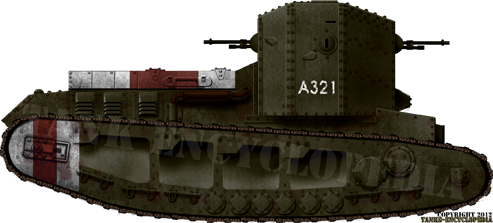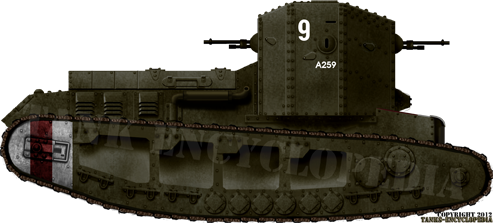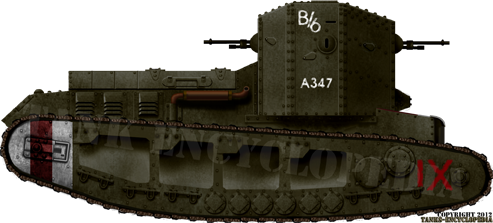The first light cavalry tank
Since the start of operations with the MK.I and IV it became clear that a slow moving vehicle was not the best solution to make any breakthrough. The idea was expressed by William Tritton, the maker of Little Willie and “Mother”, which became the Mk.I, to the newly created Tank Supply department. He expressed that a light and fast machine could better exploit the gaps made by heavier tanks in the enemy lines, reviving, in a way, the cavalry concept on a battlefield dominated by the machine-gun. This was in October 1916 and the department gave its consent on November 10. This was confirmed by the War Office on the 25th of the same month. Construction of a prototype of the “Tritton Chaser” began in December.
Design
The “Whippet” (the surname, found appropriate, was from Tritton himself) was studied and built at Fosters of Lincoln, with many features derived from Little Willie. The turret idea was revived and a prototype, hastily built on the basis of an Austin armored car, was tested in February with a rotating turret and presented on March 3rd at the “Tank trial days” before the War Office, at Oldbury. On the 4th of March, Sir Douglas Haig, the commander-in-chief of the British Army, approved an order of 200 units to be ready before the fall of July 1917. However, the heavily modified Austin showed at Oldsbury was nothing near the final prototype, and a lot of work and tests had still to be made. The Medium Mark A “Whippet” and its original shape, with a “fixed turret” at the rear, are now an iconic figure of WWI. This feature was due to the position of the engine and fuel tank at the front, and an octagonal case-mate for the crew was placed to the rear, bristling with machine-guns. The track system was entirely based on that of Little Willie, including the unsprung track links. The hull was riveted and made of reinforced iron plates, 8 to 14 mm (0.23-0.55 in) thick. The dual engine was derived from the ones propelling the well-known London “double-decker” or “imperial” buses, but required a complex steering system. Also the track skirts incorporated ingenious mud chutes.
Arrival and operations in France
The development time was approximately one year. The June 1917 deadline was not respected, and the first batch of “Whippets” were delivered in October 1917. The were immediately affected to the F battalion of the tank corps. But intensive training and instruction procedure had to follow, then shipping to France, and deployment on the front. Eventually this first operational unit was ready by December. But the whole British Army was recovering at the time from the terrible losses of the past Flanders and Somme offensives, so these tanks saw action for the first time in March 1918. They took part in covering retreating units from the Spring Offensive and later, when available in sufficient numbers, pressed into small “X-detachments” into regular Mk.IV/V units, fulfilling the embodiment of Tritton’s original ideas. During these offensives their speed and mobility proved very useful, despite their relative lack of armor. Some units penetrated deep behind German lines, creating havoc. This was confirmed even more during the April 1918 Amiens offensive. One remains famous above all. The “Musical box” was cut off from its own unit, but roamed at will for nine hours behind the German lines, wiping out an entire camp battalion, a motorized column, destroying machine-gun nests and an artillery battery and even an observation balloon, before finally being silenced by direct gunfire. Many other performed some staggering exploits, and Whippet crews were among the most decorated of WWI.
However, behind the big titles of the newspapers and propaganda of the time, these machines were far from perfect. The theoretical four-machine-gun case-mate was never seen as practical, as the 0.303 Hotchkiss Mk.I butts and fixations crowded the place. Most of the time the lateral machine-guns were simply removed, and when side fire was needed, the aft or rear ones were just shifted in place within a minute. But the major issue was the steering system. Although theoretically a brilliant concept, they would have allowed a single driver to smoothly, gradually control the speed using the throttles of both engines, each propelling a track. But this system was found to be over-complicated, even for trained drivers. In the deafening noise of action, it was not rare to use brute force and stall one or both engines. The unsprung tracks were seen by mid-1918 as an obsolete feature.
Career after the war and influences
The Germans managed to capture some, which became training machines as Beutepanzer A. One of these then operated offensively during the German revolution of 1919. Only one tank duel involving a German A7V and a Mark A was ever recorded, in April 1918. But, lacking any gun, the Whippet had soon been disabled.
Whippets saw also extensive service after the war, in Ireland with the 17th battalion of the RTC (Royal Tank Corps) and in Russia, to support the Whites during the harsh winter of 1919. Seventeen were sent, but most were captured afterwards, and the Red forces used them as “Tyeilors” (from the engine name). One of these (perhaps more) was improved with the addition of a French Puteaux 37 mm gun. Six were later sold to Japan, which studied them well, as they were their first ever tanks.
Despite the success of only two hundred machines, the Whippet was soon scheduled to be replaced. It gave way to a project of Major Wilson, former Tritton assistant, drawn in July 1918, resulting into a real scale mock-up model, and was developed into a prototype in September 1918 by Tritton’s Metropolitan Carriage and Wagon Company. The Mark B (also called “Whippet”) was accepted in service in the following month, while more than 450 were ordered. But only 47 units were delivered before the end of WWI and the cancellation of the order. Many were scrapped afterwards, but the Mark B, which combined the lozenge hull of the Mk.IV/V family with the “fixed turret” of the Mark A, pushed forward, incorporated many interesting aspects. They fought with the Whites during the Russian revolution, in 1919 and 1920 and some were captured. It was also eclipsed by next Tritton concept, the Mark C “Hornet”, in 1920.

One of the first Mark A in operations, in March 1917.

A late Whippet, A259 “Caesar II”, now in the Bovington tank museum.

The A347 “Firefly” of the sixth battalion, B company, one of the numerous “X-companies” attached to larger units made of heavy Mk.IV and V during April-May 1918. This one is now displayed at the Royal Museum of the Army in Brussels.

A Russian “Red” Whippet. It is clear that most of the 17 Mark A which were sent to the Whites in their effort to regain the country were captured by the opposing faction. This “Tyeilor” (from their engine name) in particular, was reequipped with a French Puteaux 37 mm (1.45 in) gun, for added firepower. Their fate is unknown, but six were later sent to Japan, were they constituted their very first armored forces.
Mark A Whippet specifications |
|
| Dimensions | 6.10×2.75×2.62 m (20x9x8.59 ft) |
| Total weight, battle ready | 14 tons |
| Crew | 3 |
| Propulsion | Twin Tylor 4-cyl side valve JB4 Petrol 2×45 bhp (90 bhp in all) |
| Speed | 13.4 km/h (8.3 mph) |
| Range | Around 70 km (43.49 mi) |
| Armament | 4×7.7 mm (0.303 in) Hotchkiss machine-guns |
| Armour | From 6 to 14 mm (0.23-0.55 in) |
| Total production | 200 |
Links

The Great War
 Austria-Hungary
Austria-Hungary Belgium
Belgium British Empire
British Empire France
France German Empire
German Empire Italy
Italy Russia
Russia USA
USAWW1 tanks posters

